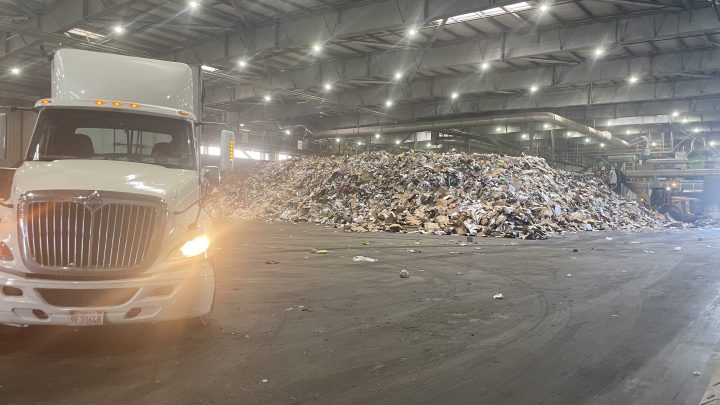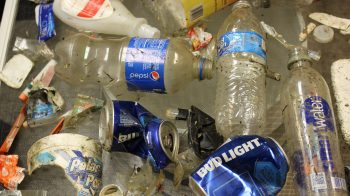
How do waste plants pick through all our unsorted recyclables?
How do waste plants pick through all our unsorted recyclables?

Many people in the U.S. live in places where they can put all their paper, glass, aluminum and plastic recyclables in one bin. Single-stream recycling is convenient for consumers, but tough for the recycling plants. It’s also less valuable than it used to be, when it was easier to sell recyclables to other countries.
At one recycling plant in Los Angeles, the starting pile of recyclable trash is large enough to hide four of the giant semi trucks offloading their hauls. This is what the trucks bring in from about 5 million people in a day.
“Some people call it the Amazon effect, but you see a lot of cardboard,” said Mark Grady, Southern California Recycling Director for Waste Management, now known as WM. It’s the largest waste hauler in the country.
Grady said the items in this pile first get shuttled onto a conveyor belt upward to a series of giant spiraling corkscrews. “Big material stays on the top, little material falls through.”
The smaller items then head for what’s called the presort room. “The sorters are trying to capture as much contamination out of the stream as possible,” said the recycling plant’s manager, Kevin Vaughn.
Half a dozen people in masks are watching what’s mostly cardboard fly by them, occasionally pulling out pieces of metal to be sorted somewhere else or unrecyclable plastics to send to the landfill. They’re pulling it off the line and dropping into one of the trash chutes along the sides of the belt.
The paper and plastic streams each head toward its own set of robot arms that identify materials that don’t belong and suck them up like carnival claws searching for stuffed animals.
Grady said each one can grab as many as a thousand pieces per minute. “It may say, ‘Hey, it’s not right for this bunker where we’re going to make this material.’ But it goes into a conveyor under us that goes back and goes through another opportunity to get picked.”
The system can recycle all but about a quarter of the stuff that comes through the facility every day, according to WM’s Southern California President Mike Hammer. “The vast majority of that is material that didn’t belong there in the first place.”
Frequent offenders include bowling balls and garden hoses. There’s also recyclable stuff that the machinery can’t catch. Perhaps the greatest headache of all: plastic bags.
“They’re problematic because of the technological aspects of it, where they wrap and they blow and they get all over,” said Hammer.
Everything that does get recycled is smushed together into giant cubes that look like hay bales, only much bigger. Hammer said those are this facility’s final, sellable product. Aluminum cans will be bought by companies that turn them into new cans.

“The aluminum cans over here may be 1% of the waste stream,” Hammer said.
Water bottles are still useful for companies that make eco-friendly toys, clothes, carpet or other things that can use recycled plastic, but that might be their last reincarnation. Cardboard boxes frequently hitch a ride on a boat to China that often returns with new cardboard boxes filled with the things Americans buying online.
The EPA reports that nationwide only about 32% of waste is recycled or composted; the biggest problem is plastics.
“Currently, very little of the plastic that consumers buy is recyclable. That is the unfortunate truth of where we are today. And we’re producing more and more plastic in our economy every year,” said CalRecycle Director Rachel Machi Wagoner.
“But doing us one better would be never creating that plastic in the first place,” she said. “So reduction of plastic bags is absolutely what we need to be doing. We need to reduce overall production of plastic in the market period.”
There’s a lot happening in the world. Through it all, Marketplace is here for you.
You rely on Marketplace to break down the world’s events and tell you how it affects you in a fact-based, approachable way. We rely on your financial support to keep making that possible.
Your donation today powers the independent journalism that you rely on. For just $5/month, you can help sustain Marketplace so we can keep reporting on the things that matter to you.



















